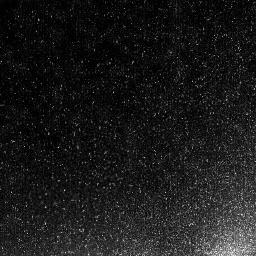
|
Cometary Flurries
- Click the image above for a larger view
- Full-Res JPEG (920 x 920) (255.6 kB)
- Full-Res TIFF (920 x 920) (847.6 kB)
Caption:
This zoomed-in image from the High-Resolution Instrument on NASA's EPOXI mission spacecraft shows the particles swirling in a "snow storm" around the nucleus of comet Hartley 2.
Scientists estimate the size of the largest particles ranges from a golf ball to a basketball. They have determined these are icy particles rather than dust. The particles are believed to be very porous and fluffy.
The sun is illuminating the nucleus from the right. This image was obtained on Nov. 4, 2010, the day the EPOXI mission spacecraft made its closest approach to the comet.
Background Info:
NASA's Jet Propulsion Laboratory, Pasadena, Calif., manages the EPOXI mission for NASA's Science Mission Directorate, Washington. The University of Maryland, College Park, is home to the mission's principal investigator, Michael A'Hearn. The spacecraft was built for NASA by Ball Aerospace & Technologies Corp., Boulder, Colo.
For more information about EPOXI visit http://www.nasa.gov/epoxi and http://epoxi.umd.edu/ .
Cataloging Keywords:
| Name | Value | Additional Values |
|---|---|---|
| Target | 103P/Hartley | |
| System | Periodic Comets | |
| Target Type | Comet | |
| Mission | Deep Impact | |
| Instrument Host | Deep Impact | |
| Host Type | Impactor | |
| Instrument | High Resolution Instrument (HRI) | |
| Detector | ||
| Extra Keywords | Atmosphere, Dust, Grayscale, Storm | |
| Acquisition Date | ||
| Release Date | 2010-11-18 | |
| Date in Caption | 2010-11-04 | |
| Image Credit | NASA/JPL-Caltech/UMD | |
| Source | photojournal.jpl.nasa.gov/catalog/PIA13623 | |
| Identifier | PIA13623 | |
